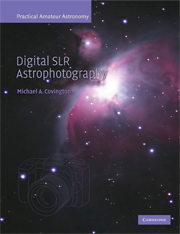Book contents
- Frontmatter
- Contents
- Preface
- Part I Basics
- Part II Cameras, lenses, and telescopes
- 5 Coupling cameras to telescopes
- 6 More about focal reducers
- 7 Lenses for piggybacking
- 8 Focusing
- 9 Tracking the stars
- 10 Power and camera control in the field
- 11 Sensors and sensor performance
- Part III Digital image processing
- Part IV Appendices
- Index
8 - Focusing
Published online by Cambridge University Press: 21 August 2009
- Frontmatter
- Contents
- Preface
- Part I Basics
- Part II Cameras, lenses, and telescopes
- 5 Coupling cameras to telescopes
- 6 More about focal reducers
- 7 Lenses for piggybacking
- 8 Focusing
- 9 Tracking the stars
- 10 Power and camera control in the field
- 11 Sensors and sensor performance
- Part III Digital image processing
- Part IV Appendices
- Index
Summary
Perhaps the biggest disappointment to any beginning astrophotographer is finding out how hard it is to focus the camera accurately. With DSLRs, the problem is even worse than with film SLRs because the viewfinder is smaller and dimmer, and also because standards are higher.
We want to focus DSLRs more precisely than film SLRs because we can. Unlike film, the DSLR sensor doesn't bend. Nor does light diffuse sideways in the image. It's easy to view the image tremendously magnified on the computer, so we are much less tolerant of focusing errors than we used to be (to our detriment) back in the film era.
Viewfinder focusing
Many astrophotographers find it unduly hard to focus an SLR manually by looking through the viewfinder. If you're one of them, it's a good idea to investigate the problem and try to build your skill. Now that we have several means of confirming focus electronically, I don't think optical focusing should stand alone, but let's get as much use out of it as we can.
The viewfinder eyepiece
The eyepiece on a DSLR is commonly out of focus. Most DSLRs have an adjustment called the eyepiece diopter (Figure 8.1) which you are expected to adjust to suit your eyes. This is rarely done, because for daytime photography with an autofocus camera, it doesn't matter. To someone who always uses autofocus, the viewfinder is just for sighting, not for focusing, and the image in it need not be sharp.
- Type
- Chapter
- Information
- Digital SLR Astrophotography , pp. 89 - 98Publisher: Cambridge University PressPrint publication year: 2007



